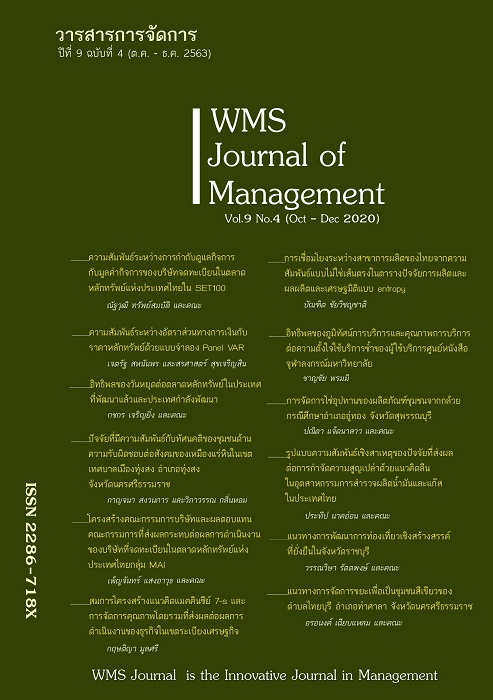The Board's Structure and Board's Remuneration Affecting to the Firm Performance of Listed Companies in the Stock Exchange of Thailand: MAI
Main Article Content
Abstract
The purposes of this research to study the board’s structure and board's remuneration affecting to the Firm Performance of Listed Companies in the Stock Exchange of Thailand in the MAI group. This is a quantitative research, collect data from the report 56-1 of listed companies in the Stock Exchange of Thailand in the MAI group continue with 5 years of operating results from the year 2014-2018, total 77 companies. Analyzed data with descriptive statistics, such as average, value Standard deviation variance, skewness and kurtosis. Inferential analysis test for variable relationships by Pearson’s Correlation Coefficient test statistics and using Multiple Regression methods to test hypotheses.
The results of the research showed that the board structure consists of the executive directors. independent directors and the of the audit committee has a negative influence on the performance of listed companies in the Stock Exchange of Thailand, the MAI group, and the board's remuneration such as monthly salaries, annual bonuses, meeting allowances, and other benefits have a positive influence on the Firm Performance of listed companies in the Stock Exchange of Thailand, MAI group, board structure and board's remuneration affects the Firm Performance of listed companies in the Stock Exchange of Thailand, MAI group with statistical significance at the level of 0.05. The board structure should be adjusted to an appropriate size. For agility in management create strategies to keep up with situations and business competition and a committee that is knowledgeable and capable to remain in that company. Directors' remuneration should be set to knowledge, board capability and in accordance with the market price Because the board or committee also plays an important role in Firm Performance.
Article Details
References
Arora, A., & Sharma, C. (2016). Corporate Governance and Firm Performance in Developing Countries: Evidence from India. Emerald Insight, Corporate Governance, 16(2), 420-436.
Bermig, A., & Frick, B. (2010). Board Size, Board Composition, and Firm Performance: Empirical Evidence from Germany.Electronic Journal June 2010, 1-48.
Brick, I.E., Palmon, O., & Wald, J. K. (2006). CEO Compensation, Director Compensation, and Firm Performance: Evidence of Cronyism?. Journal of Corporate Finance, 12(3), 403-423.
Chi, D.J., & Lee. S. (2010). The Conditional Nature of the Value of Corporate Governance. Journal of Banking and Finance. 34(2), 350-361.
Duong L., & Evans J. (2015). CFO Compensation: Evidence from Australia. Pacific basin Finance Journal, 35, 425-443.
Gillan, S.L. (2006). Recent Developments in Corporate Governance: An Overview. Journal of Corporate Finance. 12(2006), 381–402
Gulzar, A., & Wang, Z. (2011). Corporate Governance Characteristics and Earnings Management: Empirical Evidence from Chiness Listed Firms. International Journal of Accounting and Financial Reporting, 1(1), 133-151.
Jensen, M.C., & Meekling, W. H. (1976). Theory of the Firm: Managerial Behavior, Agency Costs and Ownership Structure. Journal of Finance Economics, 3(4), 305-360.
Johl, S.K., Kaur, S.,& Cooper, S. (2015). Board Characteristics and Firm Performance: Evidence from Malaysian Public Listed Firm. Journal of Economics, Business and Management, 3(2), 239-243.
Kato, T., & Long, C. (2005). Executive Compensation, Firm Performance, and Corporate Governance in Chaina: Evidence from Firms Listed in the Shanghai and ShenZhen Stock Exchanges. IZA Institue of Labor Economics Initiated by Deutsche Post Foundation, 54(4), 945-983.
Kumer, P., & Sivaramakrishnan, K. (2008). Who Monitors the Monitors? The effect of Board Independence on Executive Compensation and Firm Value. The Review of Financial Studies, 21(3), 1371-1401.
Luciano R. (2003). EBITDA as an indicator of earnings quality. Financial Markets: 22262 Journal, 29-34.
Ming, T.C., Foo, Y.B., Gul, F.A., & Majid, A. (2018). Institutional Investor and CEO pay Performance in Malaysian Firms. Journal of international accounting research. 17(1), 87-102.
Mouselli, S., & Hussainey, K. (2014). Corporate governance, analyst following and firm value. Corporate Governance: The International Journal of Business in Society, 14(4), 453466.
razalin, N., Makarov, R., & Ospanova, M. (2016). Corporate Governance and Firm Performance in The Oil and Gas Industry of Russia. Journal of Business Economics & Finance, 4(4), 710-722.
Securities and Exchange Commission Office. (2018). Corporate governance. Retrieved from http: www.set.or.th.
Shleifer, A., & Vishny, R.W. (1976). A Survey of Corporate Governance. The Journal of Finance. 52(2), 737-783.
Smith, C.W., & Watts, R.L. (1992). The Investment Opportunity set and Corporate Financing Dividend and Compensation Policies. Journal of Financial Economics, 32, 263-292.
The Stock Exchange of Thailand. (2018). History of the Stock Exchange of Thailand. Retrieved from http: //www.set.or.th-th/about/overview/history-pi.html
Tontiset, N., & Kaiwinit, S. (2013) Social responsibility accounting effectiveness of Thai-listed firms: an empirical research of its antecedents and consequences. Journal of international business and economics, 13(4), 5-24.
Vo, D., & Phan, T. (2013). Corporate governance and firm performance: Empirical evidence from Vietnam. Journal of Financial Economics, 78, 210-226.
Yermack, D. (1996). Higher market valuation of companies with a small board of directors. Journal of Financial Economics. 40(2), 185-211.


